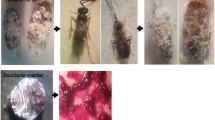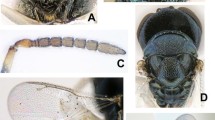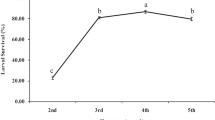Abstract
Parasitism with the cluster fly, Pollenia dasypoda Portochisky (Diptera: Calliphoridae), in relation to its host, the earthworm Allolobophora caligonosa (Sav.), was studied at Giza region, Egypt. Also, different biological parameters of the parasitoid were studied. Natural parasitism rate during March 2019 ranged between 4 and 10% per 50 earthworms. In 6 samples (300 earthworms), the total rate of parasitism was 12.66%. Experimental parasitism by placing the newly hatched larvae (L1) of P. dasypoda, directly on the bodies of their host worms, A. caligonosa, resulted to 100% parasitism in all replicates. An interesting phenomenon by larvae of the last instar (L3) of P. dasypoda appeared during the study. This parasitoid is known as an endo-parasitoid on the earthworms, where the third instar larvae (L3) complete their development inside the same parasitized earthworm. But under laboratory conditions of the present study, few individuals of L3 became ecto-parasitoids on the parasitized earthworm. The reason behind this behavior was the diameter of the host (earthworm). Experimentally, the L1 was placed on young earthworm, and when reaching the L3, its body diameter became larger than that of its host. To avoid the pressure of the host body around L3, it moves backward from the host body keeping its head with mouthparts inserted in the same location of initial parasitism, continuing feeding for 4–5 days as ecto-parasitoid, until fully developed. Then, it leaves the host and turns into a pupa adjacent to the corpus of its mostly dead host earthworm.
Similar content being viewed by others
Background
The dipteran calliphorids, known as “cluster flies,” include few endo-parasitoid species, usually recorded on different earthworm and snail species (Tawfik and El-Husseini 1971). As far as recorded in the international literature, there are more than 100 calliphorid species around the world in Palaearctic, Nearctic, Oriental, and Australasian Regions (Dear 1986; Rognes 1991, 1998). Earlier records showed that the cluster fly, Pollenia rudis (F.), parasitized earthworms in the USA and Europe, while Onesia accepta Mall. parasitized earthworms in Australia (Keilin 1911, 1915; Webb and Hutchinson 1916). In all studies, the cluster flies were found as endo-parasitoids during their larval stage of earthworms and snails. Among the available literature, less than 10 species were studied for their life cycles as predators or endo-parasitoids on earthworms (Keilin 1915; Tawfik and El-Husseini 1971; Yahnke and George 1972; Richards and Morrison 1972; Szpila 2003; Grzywacz et al. 2012).
In the present study, an astonishing phenomenon was noticed during studying the parasitism rate of P. dasypoda on A. caligonosa under laboratory enforcement. As usual, all the third larval instars of the parasitoid, P. dasypoda complete their development inside the body of the host. In some cases, the third instar larvae come out of the host body and complete their larval development feeding externally on the same host for 4–5 days. Thus, we looked after the reason(s) behind this phenomenon in which this endo-parasitoid acted as an ecto-parasitoid.
Material and methods
Large numbers of the earthworm A. caligonosa were collected in March 2019 by digging in freshly irrigated soil cultivated with the Egyptian clover, Trifolium alexandrinum L., at the Experiment Station, Faculty of Agriculture, Cairo University, Giza, Egypt, and transferred to the Center of Biological Control for the study. The collected earthworms (300 individuals) were divided into 6 groups, each of 50 worms. The earthworms were examined individually under a stereoscope to separate those parasitized by larvae of the fly. The natural parasitism rate was estimated. Each parasitized earthworm was kept in a moistened field soil in a glass container covered with muslin cloth fitted in place with a rubber band until the parasitoid larvae left their hosts and pupate in the soil. The pupae were then collected by soft forceps and placed vertically in a moistened soil with the cephalic ends upwards and kept in caged until adult emergence. The emerged flies were kept in cloth ovipositional cages (20 × 20 × 30 cm) supplied with 5 Petri dishes (ɸ5 cm) filled with moistened field soil, as sites for oviposition, and a wetted piece of cotton wool soaked in a diluted bee honey (1:5 honey:water) as nutrient for the adult flies. They were left under laboratory conditions (25 °C) for incubation and hatching. The newly hatched larvae (similar to Planidia) were active in searching for their hosts (A. caligonosa) in the soil. Each larva was picked up by a tip of wetted fine camel brush and placed onto the body of a healthy earthworm, kept individually with moistened field soil in Petri dishes, where parasitism took place. Five replicates, each of 50 exposed earthworms, were used for the test besides the control (50 healthy untreated earthworms). Different biological parameters of P. dasypoda were measured: egg incubation period, larval durations and measurements, pre-pupal and pupal periods, adult fecundity, longevity, and sex ratio. The treated earthworms, as well as those of the control, were not all at similar sizes and/or ages because they were collected as wild individuals from the irrigated fields. Rate of parasitism among exposed earthworm individuals to the parasitoid larvae was under laboratory conditions calculated. Cases of ecto-parasitism by the third instar larvae (L3) of P. dasypoda were counted, and the diameter/width of both the larva and its host (earthworm) was measured.
Results and discussion
Biological parameters
Egg stage
Laid eggs could be seen with naked eyes or small lens (× 10) characterized by their Perl-white color; when magnified, two longitudinal aeroscopic structures could be seen on the ventral side (Fig. 1a) through which the respiration of the embryo is facilitated in the moist soil. The chorion is sculptured with tiny pits and ridges forming a reticulate pattern. A minute funnel-like area at the anterior pole of the egg contained the micropile. Eggs were laid on soil surface on their ventral side which is flattened. The dorsal side of the egg is concaved. Data in Table 1 show that laid eggs measure 1.03 mm long and 0.31 mm in width. The incubation period under the experimental laboratory conditions ranged between 3 and 5 days with an average of 4.4 days (Table 1).
Pollenia dasypoda. a Eggs magnified showing aeroscopic structure on the ventral side. b Posterior end of larva showing posterior spiracles protruding outside the host body (Allolobophora caligonosa) (endo-parasitism). c Freshly formed fly pupa adjacent corpus of the parasitized host. d Full-grown parasitic L3 feeding externally on the earthworm (ecto-parasitism)
Larval stage
Morphological description of the three larval instars of P. dasypoda was provided by Tawfik and El-Husseini (1971). Data presented on Table 1 show that the duration of the first larval instar (L1) ranged between 4 and 6 days with an average of 5.2 days. Its length and width averaged 1.03 and 0.31 mm, respectively. The second instar larva (L2) developed in a period of 3–4 with an average of 3.5 days. On the average, it measured 2.60 and 0.83 mm in length and width, respectively. Meanwhile, the third instar larva (L3) durated 6–7 days with an average of 6.8 days. It was the largest larval instar, and its length measured 41.55 mm on the average (40.23–43.22 mm) and 4.44 mm (4.11–4.89 mm) in width.
Pre-pupal and pupal stage
As seen in Table 1, the pre-pupal period from the time the third instar larva left its host to transform into pupa lasted 1–2 days with an average of 1.4 days. Turned into a pupa, its length measured 34.2–39.4 mm with an average of 37.45 mm. Its width ranged between 3.11 and 3.45 mm with an average of 3.14 mm. The pupal period ranged 19–23 days and averaged 20.6 days.
The total developmental period of the immature stages of P. dasypoda ranged between 36 and 47 days with an average of 41.9 days (Table 1).
Oviposition activity and adult longevity of P. dasypoda
The pre-oviposition period ranged between 8 and 21 days with an average of 11.36 days (Table 2). Meanwhile, this period was 19–56 (31.5) and 0–54 (18.9) days for the oviposition and post-oviposition periods, respectively. During a longevity period of 48–96 days (aver. 70.55 days), a single female laid a daily number of eggs ranging from 96 to 206 with an average of 165.36 eggs/day. The total number of eggs laid per female was 338–351 with an average of 456.5 eggs. Meanwhile, males lived shorter than females showing longevity of 40–61 days with an average of 56.7 days.
Sex ratio
Additional sampling of the earthworm A. caliginosa collected from T. alexandrinum fields resulted the emergence of 39 adult males and 51 adult females of P. dasypoda. Accordingly, the sex ratio is apparently 1:1.3.
Natural rate of parasitism
The field-collected individuals of the earthworm A. caligonosa showed a rate of 4–10% individuals parasitized by larvae of the cluster fly P. dasypoda during March 2019 (Table 3).
The total numbers of parasitized earthworms recorded 34 individuals out of the 300 field-collected individuals, representing 12.66% parasitism. Although the adult female of the cluster fly has a life span of 2 months on the average and a high fecundity (530 eggs) (Tawfik and El-Husseini 1971), this rate of parasitism seems to be less than could be expected. But in nature, the first instar larva dies within 2–4 days, when failed to reach an earthworm. Thus, A. caligonosa poses such a high fecundity to keep existing in nature through the survived progeny. In all parasitized earthworms collected from the field, each harbored only one parasitoid larva. Thus, it seems that P. dasypoda so far is a solitary parasitoid.
Experimental rate of parasitism
A pale pink-colored spot appeared on the body of the earthworm indicating the site of penetration by the like-planidium stage (first instar larva) of the parasitoid. At the middle of the pale spot, the end of the anal portion of the parasitic larva protruded visibly with its pair of spiracles from the host skin permitting direct air respiration (Fig. 1b). The third larval instars were differentiated from each other, under a stereoscope, through the number of openings on the posterior visible spiracles. Each spiracle was structured by 1, 2, and 3 openings in the first, second, and third instar larvae, respectively (Tawfik and El-Husseini 1971). The five replicates of the directly exposed earthworms (A. caligonosa) to hatch larvae of the parasitic cluster fly (P. dasypoda) showed a 100% successful parasitism, examined through 10 days after exposure under laboratory conditions. Such a high rate of parasitism is related to the active mobile or migratory first instar larva (L1), which is similar in the habit of the “planidium stage” of other parasitoids. Here, the first instar larvae were placed directly on the skin of the earthworms in which the parasitoid larvae started boring into the body wall of the earthworm by their sharp mouthpart structure. Completely developed L1 molts into L2 without changing the location of parasitism with its posterior end bearing the spiracles protruding at the body surface of the host. Usually, the L3 is found in the same location until completing its development and leaves the body of the host to pupate in the soil adjacent to the corpus of its host (Fig. 1c).
Endo- and ecto-parasitim by P. dasypoda in A. caligonosa
Data presented in Table 4 realize that the diameter of the host body was the factor influencing the type of parasitism (endo- or ecto-parasitism?). The mean diameter of the endo-parasitized earthworm (3.85 mm) was found always larger than that of the parasitoid L3 (2.90 mm), which allowed the parasitic L3 larva to live inside its host as endo-parasitoid. In the case that the diameter of the parasitized earthworm (2.35 mm) was less than that of the newly molted parasitoid L3, and due to the narrow space pressuring around the parasitoid larva (L3), it crawled backwards out of the pressure of its host body, but kept its head with mouthparts inserted in the same opening. Thus, it fed for 4–5 days on the tissues and fluids of its host, while its body located outside, i.e., behaving as an ecto-parasitoid until it fully developed. Then, it separated itself from the host worm for pupation adjacent to the corpus of its mostly dead host (Fig. 1d). Available literature revealed that this phenomenon in which the early immature feeding stage (L1 and L2) behaves as an endo-parasitoid and during the late stage (L3) of the same species, it behaves as an ecto-parasitoid because of the host narrow diameter than its body. Such behavior has not been previously recorded among the calliphorid parasitoids.
Conclusion
The cluster fly, Pollenia dasypoda Portochisky, is known as endo-parasitoid on the earthworms, where all the three instar larvae complete their development inside the same parasitized individual of the earthworm. Under laboratory conditions, the present study revealed the phenomenon in which the early immature feeding stage (L1 and L2) behaved as an endo-parasitoid and during the late stage (L3) of the same species and behaved as an ecto-parasitoid because of the host narrow diameter than its body. Such behavior has not been previously recorded among the calliphorid parasitoids.
Availability of data and materials
All data are available at the article, and the materials used in this work are of high transparency and grade.
Abbreviations
- L1 :
-
First instar larva
- L2 :
-
Second instar larva
- L3 :
-
Third instar larva
References
Dear JP (1986) Calliphoridae (Insecta: Diptera). Fauna of New Zealand 8:1–86
Grzywacz A, Szpila K, Pape T (2012) Egg morphology of nine species of Pollenia robineau-Desvoidy, 1830 (Diptera: Calliphoridae). Microsc Res Tech 75:955–967
Keilin D (1911) On the parasitism of the larvae of Pollenia rudis Fab. In: Allolobophora chloroticata Savigny. Ent Soc Wash Proc XIII, pp 182–184
Keilin D (1915) Recherches sur les larves de Dipteres cyclorhapes. Cycle evolutif de Pollenia rudisFabr., parasite d’Allolobophora chlorotica Sav—Biologie comparée des larves dediptères. Bull Sci Fr Belg 49:15–198
Richards PG, Morrison FO (1972) The egg and chorion of Pollenia rudis (Fabricius) (Diptera: Calliphoridae). Can J Zool 50:1676–1978
Rognes K (1991) Blowflies (Diptera, Calliphoridae) of Fennoscandia and Denmark. Fauna Entomologica Scandinavica 24:272
Rognes K (1998) Family Calliphoridae. In: Papp L & Darvas B (eds) Contributions to a manual of palaearctic Diptera (with special reference to flies of economic importance), Vol. 3. Higher Brachycera. Science Herald, Budapest, pp 617–648
Szpila K (2003) First instar larvae of nine West-Palaearctic species of Pollenia Robineau-Desvoidy, 1830 (Diptera: Calliphoridae). Entomol Fennica 14:193–210
Tawfik MFS, El-Husseini MM (1971) Life-history of Pollenia dasypoda Portochisky, a parasite of the earth worm, Allolobophora caliginosa (Sav). Bull Soc Ent Egypte 55:275–287
Webb JL, Hutchinson RH (1916) A preliminary note on the bionomics of Pollenia rudis Fabr. America Wash Ent Soc Proc XVIII, pp 197–199
Yahnke W, George JA (1972) Rearing and immature stages of the cluster fly (Pollenia rudis) (Diptera: Calliphoridae) in Ontario. Can Ent 104:567–576
Acknowledgements
The author thanks and highly appreciates the assistance of Eng. Ata A. Ata at the Center of Biological Control.
Funding
This work was not supported by any funding body, but personally financed.
Author information
Authors and Affiliations
Contributions
The author read and approved the final manuscript.
Corresponding author
Ethics declarations
Ethics approval and consent to participate
I agree to all concerned regulations.
Consent for publication
I agree to publish this scientific paper at the EJBPC.
Competing interests
The author declares that he has no competing interests.
Additional information
Publisher’s Note
Springer Nature remains neutral with regard to jurisdictional claims in published maps and institutional affiliations.
Rights and permissions
Open Access This article is distributed under the terms of the Creative Commons Attribution 4.0 International License (http://creativecommons.org/licenses/by/4.0/), which permits unrestricted use, distribution, and reproduction in any medium, provided you give appropriate credit to the original author(s) and the source, provide a link to the Creative Commons license, and indicate if changes were made.
About this article
Cite this article
El Husseini, M.M.M. Endo- or ecto-parasitism with the cluster fly, Pollenia dasypoda Portochisky (Diptera: Calliphoridae), based on the diameter of its host body, the earthworm Allolobophora caligonosa (Sav.). Egypt J Biol Pest Control 29, 49 (2019). https://doi.org/10.1186/s41938-019-0150-8
Received:
Accepted:
Published:
DOI: https://doi.org/10.1186/s41938-019-0150-8





